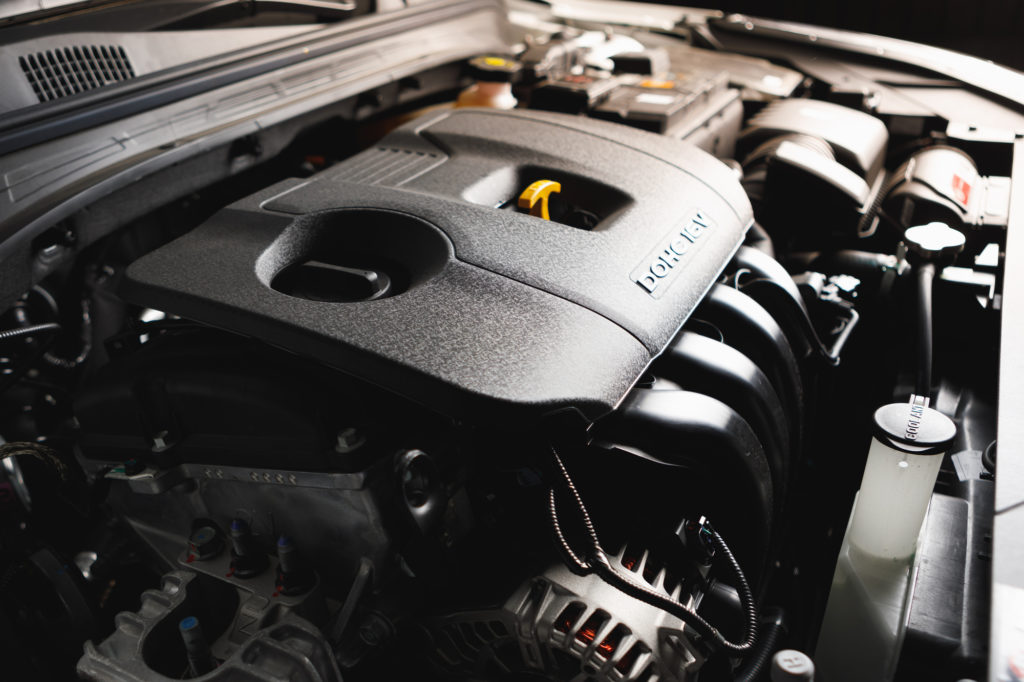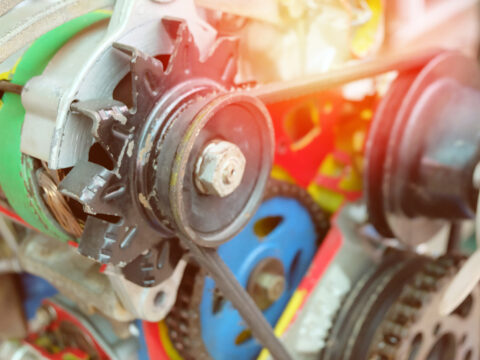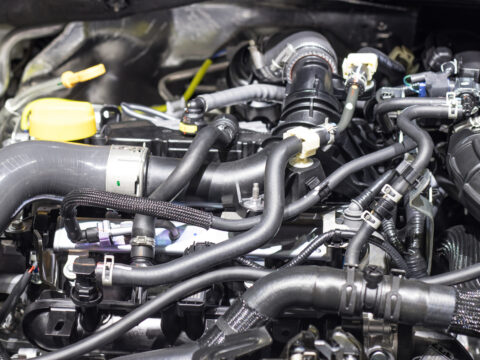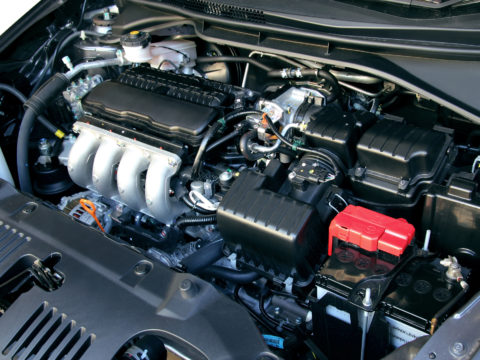Carmakers seem to have fallen in love with acronyms. Did you know that BMW stands for Bayerische Motoren Werke?
And when it comes to the design of their engines, one of the letter combinations you might see used to describe a car is DOHC.

Contents
What Do the Initials DOHC Mean?
Carmakers use combinations of letters to denote their unique models, advanced systems like Electronic Stability Control (ESC), and sometimes even the name of their company. But what does it mean when you notice the DOHC emblem or insignia on a vehicle or when listed on the spec sheet for a particular engine?
You first have to know that DOHC stands for Dual Overhead Camshaft. We have to talk about some engine basics to understand what that means. Motors have an engine block, housing the cylinders where internal combustion happens.
A mix of fuel and air feeds that process, and combustion occurs when a spark ignites the mixtures. The energy created by combustion in the cylinders yields the power that turns the wheels and drives the car, as well as hot exhaust gasses that must escape the cylinders and flow out of the car.
Accordingly, engines have a series of valves that control the flow of the intake and exhaust. Using two camshafts to actuate the rotation of the valves allows engine builders to control the intake and exhaust valves separately, instead of other arrangements with only one camshaft that lack that precision.
By taking control of the exhaust and intake valves independently, this arrangement offers engineers greater control over the fuel consumption of the engine and the exhaust flow created by combustion.
The end result is that modern DOHC engines typically achieve greater efficiency, better economy and also make more power than Single Overhead Camshaft (SOHC) motors or their pushrod predecessors.
So, DOHC isn’t just an advertising gimmick. It’s a real-world technology that’s important to understand, especially if you’re buying an engine.
DOHC Engine Diagram
This little animation is an outstanding DOHC engine diagram. It shows the motion of the camshaft on top of the engine and how the valves interact with the pistons. You can see that there are two valves for each piston on each camshaft, making a total of four valves per cylinder.
By tuning the timing of these valves, engineers can tweak the motor for increased power and efficiency.
The History of the DOHC Engine
The DOHC engine’s origin lies in the engineering department at Peugeot, a French car manufacturer. Previous motors typically had what’s called an Overhead Valve (OHV), where the camshaft sits below the valve inside of the engine’s block or a Single Overhead Cam (SOHC) design.
SOHC motors are a step up from OHV motors in many ways. But OHV motors are still the backbone of most small engine applications like you’d find on water pumps and other outdoor equipment.
The engineers and designers at Peugeot saw an opportunity to increase the power of their motors by adjusting the valve timing. They realized that by using two camshafts on top of the motor, they could increase their control of the engine’s intake and exhaust valves separately.
Their efforts were rewarded with success in the racing world in 1912, proving the concept of DOHC. Their triumph on the race track demonstrated that their DOHC design had advantages over other previous engine designs that made less power.
This early development led to continuing research and the evolution of the modern internal combustion engine, and much of their original design lives on in the engines of modern vehicles.
How Does a DOHC Engine Work?
A DOHC engine functions very similarly to SOHC motors. Combustion occurs in the block, and the camshaft on top controls the valves. But, there is one major difference. Instead of controlling the valves with one camshaft, two camshafts on top of the engine control the motion of the valves, usually separating the exhaust valves from the intake valves.
But why does one camshaft control the exhaust valves while the other controls the intake valves? This gives engineers and designers the ability to finely tune both the intake’s mixture of fuel and air that combusts when a spark is introduced and the timing of the flow of the exhaust gasses out of the cylinder after combustion.
Without being overly technical, this differentiation yields both increased power through optimization of the intake mix for combustion and increased efficiency.
Plus, the layout allows improved placement of the spark plug, which ignites the combustion process inside the cylinders. The efficiency of the DOHC motor also goes hand-in-hand with modern turbocharged engines that are designed for both power and economy to meet new eco-standards.
DOHC Engine Full Specs
Let’s look at some specific examples of DOHC engines. This table highlights some engines you might see on the market and their specifications.
| Engine | # of Cylinders | # of Cams | # of Valves | Horsepower |
| Toyota 1ZZ-FE | 4 | 2 | 16 | 143 |
| Chevy LT6 | 8 | 2 | 16 | 670 |
| BMW M62 | 8 | 4 | 32 | 282 |
DOHC Engine Configuration
Dual overhead camshaft engines come in many different configurations. For instance, smaller four-cylinder engines, where the four cylinders are arranged in a straight line, have two camshafts operating the valves. Since everything is in a straight line, it’s a pretty simple DOHC configuration, and it’s quite common.
Some motors, particularly those with a V-shaped cylinder configuration, have four camshafts. That’s because the cylinders aren’t in a straight line, so instead of one cam for intake valves and another for exhaust valves, they instead have two camshafts for each bank of cylinders.
They’re still DOHC motors, but sometimes they are referred to as quad-cam or four-cam engines. The configuration of the motor has implications beyond power and efficiency. For instance, if you build an inline 12-cylinder motor, it might be twice as long as a V12 motor with two banks of six cylinders.

DOHC Engine Performance Review
DOHC engines tend to have two significant advantages over their counterparts. They are much more efficient and also more powerful since they can be tuned a lot more precisely. In addition, they tend to be much smoother-running due to their precision and variability of valve timing to match the demands placed on the engine.
If there are knocks on DOHC engines, it comes from their increased complexity. Since they have more parts and they are all in motion during the engine’s operation, DOHC motors are more expensive to build and maintain if things go wrong. More parts equal more chances for wear and damage and potential breakdown. They are also quite sensitive to changes in oil pressure.
Since there are so many different engines featuring a DOHC configuration, it’s hard to make a definitive statement about their performance across the board. But, one thing is clear: DOHC engines are a huge step up from previous configurations featuring single overhead cams or builds where the valves are above the camshaft.
That’s why most modern cars feature DOHC motors.
DOHC Engine Advantages and Disadvantages
DOHC motors are very common. But, they do have some pluses and minuses to be aware of if you’re shopping for a car or even just discussing the aspects of engines.
Even within the world of DOHC motors, there is considerable variation. And there are some SOHC motors that are true engineering marvels that make plenty of power and are quite efficient.
Here are some general pros and cons of DOHC engines.
Pros
- Optimized for ideal sparkplug layouts
- Able to produce more horsepower
- More efficient in general
- Increased fuel economy
- Smoother operation with less misfiring
Cons
- More parts that could break
- More complicated to repair
- Increased cost of engineering
- Sensitive to changes in oil pressure
What Cars Have DOHC Engines?
The better way to ask this question might be to wonder which cars don’t have a DOHC engine. That’s because the modern automobile market is geared toward performance with efficiency, and the DOHC engine is ideal for that application. Most modern cars, and almost all current cars with turbocharged engines, have DOHC engines.
But, some manufacturers prefer the simplicity and cheaper manufacturing cost of the SOHC design. For instance, Honda manufactures some engines that feature a SOHC. Their J-series V6 motor is one example. And most of their small motors designed for powering equipment also feature SOHC or OHV designs.
That’s because simple machines don’t need complicated engines to get the job done, and making these sorts of motors into DOHC systems makes little practical or financial sense.
A DOHC setup can be overkill for some applications where weight and simplicity are the biggest priorities. Plus, most homeowners trying to maintain a gas-powered appliance don’t have the expertise to work on more complicated DOHC engines.
DOHC Engine Maintenance
DOHC engine maintenance is a bit more complicated than some simpler designs. That’s because there are a lot of moving parts that are essential to the operation of a DOHC motor. More parts mean more things that could conceivably go wrong, and once you start taking things apart, there is more to put back together.
However, DOHC motors are very reliable in general. It’s when they need repairs that their complexity becomes an issue. And, since they’re so common, most engine repair shops have plenty of experience dealing with repairs. Though, sometimes, it’s cheaper to replace an engine than to repair any significant damage.
How Much Does a DOHC Engine Cost?
DOHC engines range from small, inexpensive, and utilitarian to large, expensive, and astoundingly exotic. For example, the Ferrari 812 features a DOHC V12 that has about 800 horsepower on tap. This exotic DOHC motor offers extreme performance and costs hundreds of thousands of dollars.
At the other end of the spectrum, the new 2022 Kia Carnival has a 3.3 liter V6 with a DOHC design. But, it costs less than one-tenth the price of the V12 Ferrari. So, there is incredible diversity in the design and pricing of V12 engines.
However, in comparison to SOHC engines, DOHC motors are almost always more expensive. That’s due to the increased engineering costs to create them and the more complicated assembly required to produce them in a factory. Additionally, DOHC motors have more parts, so that pushes the price up as well.
For car owners, the DOHC engine’s configuration offers more performance and better efficiency in general but also opens the door to increased repair costs if the engine needs significant repairs. Plus, you’ll typically shell out a bit more money upfront.
Who Sells the Engine?
Most major car manufacturers sell vehicles with DOHC engines. But, not every engine has to come in a car. There are also motors designed for other applications, like planes, tractors, motorcycles, and small outdoor appliances and equipment.
So, while you can find a DOHC engine at the heart of the mighty Chevy Corvette Z06, you can also find one in various small cars like the Fiat 500. You can also find DOHC motors in tractors and other heavy equipment.
Toyota offers an entire lineup of engines for industrial equipment, and many of them feature a DOHC configuration. So, you can find DOHC engines offered for almost any application. But, since SOHC motors are generally lighter, they might be ideal for lightweight vehicles. They are often found powering airplanes.
And now that you know all about them, as well as their strengths and weaknesses, you can figure out if a DOHC motor is suitable for you.














